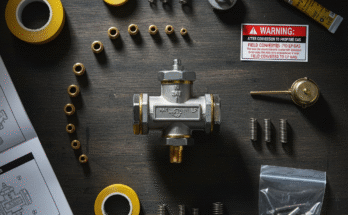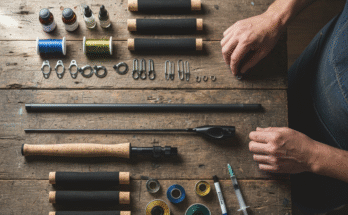Have you ever considered switching your home’s gas appliances from natural gas (NG) to Liquid Propane (LP) or propane? Perhaps you’re moving to a rural area without natural gas lines. Maybe you simply want a more portable or controllable fuel source. Whatever your reason, you don’t necessarily have to replace all your perfectly good appliances. A small but mighty package often provides the solution: the propane conversion kit.
This comprehensive guide will demystify the propane conversion kit. We will explain what it is, why it’s essential, what it contains, and the critical safety precautions you must follow.
What Is a Propane Conversion Kit?
A propane conversion kit is a set of specialized parts. It modifies a natural gas appliance—like a furnace, water heater, boiler, range, or cooktop—so it can operate safely and efficiently on propane.
The fundamental difference between the two fuels makes a conversion necessary:
- Natural Gas (NG) is primarily methane. Suppliers deliver it at a lower pressure (typically about 7 inches of water column or W.C.).
- Propane (LP) is a mix of gaseous hydrocarbons. Suppliers deliver it at a significantly higher pressure (typically 11 inches W.C.). Propane also has more heat energy per unit volume than natural gas.
Burning a higher-pressure, more energetic fuel like propane through an appliance designed for lower-pressure natural gas would cause an overly large, unsafe, and fuel-wasting flame. The conversion kit addresses this difference. It regulates the gas flow and ensures the proper air-to-fuel mixture for clean, efficient combustion.
Why Convert to Propane? The Advantages
Converting your appliances to propane offers several compelling benefits:
- Portability and AvailabilityPropane is stored in tanks on your property. This makes it an ideal energy source for homes off the natural gas grid, especially in remote or rural locations. This energy independence means you don’t rely on a utility company’s pipeline infrastructure.
- Efficiency and Energy DensityPropane contains more than twice the British Thermal Units (BTUs) of energy per cubic foot compared to natural gas. This higher energy density translates into more efficient heating and faster cooking times.
- Price ControlYou are often locked into the utility company’s pricing with natural gas. Propane, however, is delivered by third-party suppliers. You can shop around for the best price. You can even time large purchases when market prices are low, giving you more control over your energy budget.
- VersatilityPropane can power a huge range of appliances, including furnaces, boilers, water heaters, ranges, clothes dryers, and even backup generators. A single LP tank can often fuel an entire home.

Inside the Kit: Essential Components
The exact components of a propane conversion kit will vary by appliance manufacturer and model. The most critical parts, however, manage the change in gas pressure and energy density:
- Burner Orifices (Gas Jets)These are perhaps the most vital part of the kit. An orifice is a small, precision-drilled brass fitting located at each burner.
- Natural gas orifices have a larger hole. This accommodates NG’s lower pressure and lower energy content.
- Propane orifices have a smaller hole. This restricts the flow of the higher-pressure, higher-energy propane. It ensures the correct amount of fuel is delivered to the burner for a controlled flame.A conversion kit will include a set of these smaller orifices for every burner on the appliance (cooktop, oven, broiler, etc.).
- Pressure Regulator ComponentsThe gas pressure regulator maintains a consistent gas pressure to the appliance burners. For conversion, you must replace or adjust the internal components of the existing regulator—or sometimes the entire regulator.On many newer gas ranges, the regulator has a convertible spring/plunger inside its cap. The conversion process often involves simply flipping this component. This switches the regulator’s set point from the NG pressure to the higher LP pressure.
- Gas Valve AdjustmentsSome gas valves and oven thermostat controls have adjustment screws or plates. You may need to turn or swap these to calibrate the air-to-fuel ratio. This ensures a proper, clean-burning blue flame on propane.
- Decals and InstructionsBy law, you must update an appliance’s rating plate (nomenclature) once it is converted to reflect the new fuel type (LP). The kit will include a new sticker or metal plate. You must permanently affix it to the appliance. The kit also includes the detailed, model-specific instructions a qualified technician must follow.
Safety First: The Professional Conversion Mandate
Here’s the most critical takeaway regarding propane conversion kits: This is not a do-it-yourself project.
A qualified, licensed gas fitter, service agency, or the local gas authority must perform the installation.
Attempting a propane conversion yourself, even with the kit and instructions, is extremely dangerous and can lead to:
- Fire or Explosion: Improperly sized orifices or incorrect pressure settings can allow too much gas to flow to the burners. This causes an uncontrolled flame, overheating, or a dangerous buildup of gas.
- Carbon Monoxide (CO) Poisoning: Incorrect adjustment of the air-to-fuel mixture leads to incomplete combustion. This produces carbon monoxide, a deadly, odorless, and colorless gas. A qualified technician will use a calibrated combustion analyzer. They ensure the air/fuel mixture is perfect and the appliance is burning cleanly and safely.
- Appliance Damage: Running an unconverted or improperly converted appliance on propane can cause irreparable damage to components. It can also dramatically shorten the unit’s lifespan.
- Voided Warranties and Insurance: Most manufacturers and insurance providers will void warranties and coverage. This happens if they discover an unlicensed individual performed a conversion or did not follow the manufacturer’s specifications strictly.

A Professional’s Process Includes:
- Shutting Off All Gas and Power: They ensure complete safety before disassembly.
- Replacing Orifices: They install the correct, smaller LP orifices for all burners.
- Converting the Regulator: They adjust or replace the pressure regulator for the higher LP pressure.
- Air Shutter Adjustment: They change the air shutters (or air baffles) to fine-tune the oxygen mixture. This is crucial for a stable, blue flame.
- Leak Testing: They use a special leak detector or soapy water solution. They meticulously check all connections for leaks.
- Combustion Analysis: They use a specialized analyzer to measure the flue gases (like CO and
). This confirms optimal, clean, and safe combustion.
- Updating Documentation: They affix the new LP rating plate to the appliance and provide a certificate of compliance for the work performed.
What Appliances Can Be Converted?
The vast majority of modern natural gas appliances are “field convertible.” This means the manufacturer designs them to be convertible to propane. The conversion kit is often included with a new appliance purchase, attached somewhere near the regulator or inside the packaging.
However, not all older or specialized appliances can be converted.
- Check the Manufacturer: Always confirm your appliance’s model number with the manufacturer or a licensed technician. They can tell you if an approved conversion kit exists and if your specific model is convertible.
- High Altitude: Be aware that high-altitude installations (typically above 2,000 to 4,000 feet) may require different, even smaller orifices than the standard kit. Thinner air affects combustion. The technician must account for this.

The Final Flame: A Worthwhile Investment
A propane conversion kit is much more than just a box of metal parts. It’s a crucial tool that unlocks the versatility and benefits of Liquid Propane for your home. It’s the bridge between two different fuel systems. Its proper installation is a matter of both efficiency and absolute safety.




